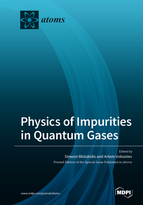Physics of Impurities in Quantum Gases
A special issue of Atoms (ISSN 2218-2004).
Deadline for manuscript submissions: closed (31 March 2022) | Viewed by 36784
Special Issue Editors
Interests: ultracold quantum gases; quantum impurities; quasiparticles; correlated nonequilibrium dynamics of atomic mixtures and transport phenomena; impurity-impurity correlations; entanglement between impurity atoms and bath; nonlinear and topological excitations in multicomponent quantum systems; spinor gases; few-body two-component systems; strongly correlated quantum systems; physics of optical lattices; quench dynamics; driven quantum systems; few to many-body physics
Special Issue Information
Dear Colleagues,
A problem of a mobile impurity in a quantum many-body environment is often reduced to an effective one-body model. This reduction is connected to the concept of a quasiparticle such as a polaron. The quasiparticles enjoy exciting physics that go beyond a minor change of the corresponding bare impurities. The underlying dressing mechanism strongly modifies single-particle properties of the impurity, such as its mass. Remarkably, it also affects impurity-impurity interactions, which usually become more attractive and might even support different types of additional bound states.
Recently, quantum systems with impurities have been realized in cold-atom experiments. These experiments offer a unique possibility to study, for instance, the spectra, the residua, and the effective mass of the generated quasiparticles, to monitor the trajectories of the impurities and even to witness induced impurity-impurity correlations. They spur a wave of theoretical works on the dynamical and static properties of quasiparticles, with particular focus on emergent correlation effects. Notable phenomena, beyond simple single-particle characteristics, include nonlinear pattern formation, induced impurity-impurity correlations, relaxation processes, and peculiar transport properties. All of the above-mentioned activities are a part of an exciting discussion that shapes our understanding of quasiparticles.
The aim of this Special Issue of Atoms is to contribute to this discussion by highlighting recent advances regarding the physics of impurities in quantum gases. The Special Issue will collect theoretical and experimental works dedicated to fundamental properties and universal aspects of quasiparticles, as well as to applications of the quasiparticle concept in different contexts such as trapped mixtures of bosons or fermions, Rydberg systems, cavity settings, etc. The Special Issue will contain studies of multicomponent setups and quantum mixtures, ranging from the many-body correlated dynamics to ground state properties of few particles, and few-body processes that play a role in many-body systems with impurities. We invite authors to submit original research as well as short pedagogical reviews and communications with technical details that can lead to a substantially improved understanding of the existing theoretical and experimental results.
Dr. Simeon Mistakidis
Dr. Artem Volosniev
Guest Editors
Manuscript Submission Information
Manuscripts should be submitted online at www.mdpi.com by registering and logging in to this website. Once you are registered, click here to go to the submission form. Manuscripts can be submitted until the deadline. All submissions that pass pre-check are peer-reviewed. Accepted papers will be published continuously in the journal (as soon as accepted) and will be listed together on the special issue website. Research articles, review articles as well as short communications are invited. For planned papers, a title and short abstract (about 100 words) can be sent to the Editorial Office for announcement on this website.
Submitted manuscripts should not have been published previously, nor be under consideration for publication elsewhere (except conference proceedings papers). All manuscripts are thoroughly refereed through a single-blind peer-review process. A guide for authors and other relevant information for submission of manuscripts is available on the Instructions for Authors page. Atoms is an international peer-reviewed open access monthly journal published by MDPI.
Please visit the Instructions for Authors page before submitting a manuscript. The Article Processing Charge (APC) for publication in this open access journal is 1500 CHF (Swiss Francs). Submitted papers should be well formatted and use good English. Authors may use MDPI's English editing service prior to publication or during author revisions.
Keywords
- Quantum gases and mixtures;
- Systems with impurities;
- Polarons;
- Rydberg polarons;
- Polaritons;
- Induced interactions;
- Bipolarons;
- Pattern formation;
- Multicomponent few-body systems;
- Engineering of Hamiltonians (correlations);
- Few-body scattering processes;
- Experimental techniques in quasiparticle and few-body physics






